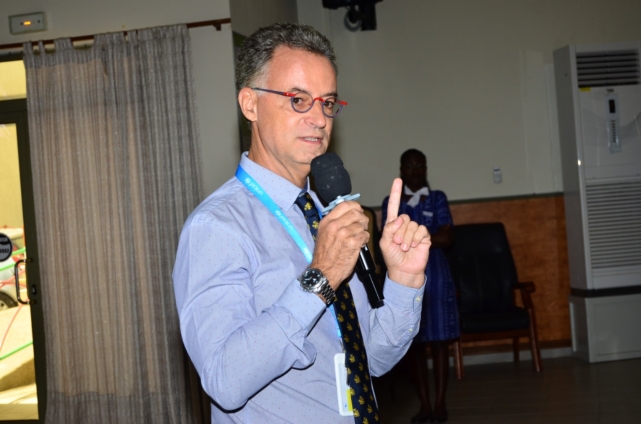Data available to UNICEF shows that a lot more teenagers particularly girls, are increasingly contracting HIV and AIDs infections in West and Central Africa as compared to other parts of the world.
Speaking to the Global AIDS Monitoring and UNAIDS 2022 estimates report, UNICEF Chief of Health, Alexandre Boon said the situation could be a result of “many things and many circumstances or behaviours - either social, related to poverty or related to the circumstances of where these adolescents live - but also because of the vulnerability of the adolescent, particularly when they indulge in unprotected sex’’.
He added that, unlike boys, girls are more susceptible to sexually transmitted diseases including HIV due to their level of sexual activity and vulnerability.
Mr Boon explained that this disposition of girls naturally predisposes them to new infections as compared to their male counterparts.
These factors coupled with a host of challenges confronting the sub-region are to blame for the phenomenon.
Also among the regional challenges compounding the threat to adolescents’ health are the limited engagement of community health workers in HIV/AIDS service delivery, as well as the low availability of adolescent and youth-friendly health services in countries recording higher figures.
According to the Global AIDS Monitoring and UNAIDS 2022 estimates report, West and Central Africa is one of the regions in the world where children and adolescents are most affected by HIV, putting them just behind East and Southern Africa.
Sharing details of the data with members of the Africa Media Network for the Promotion of Health and Environment (REMAPSEN) at a workshop in Lome, UNICEF’s Chief of Health in Africa, Alexandre Boon, said “despite advances in recent years, particularly in reducing HIV transmission from mother to child, attention and support for children and adolescents living with HIV remains insufficient."
Alexandre Boon believes this is among the myriad of factors aggravating the prevalence of cases, particularly among adolescent girls in Africa.
He said, ‘’In some countries where the incidence and the prevalence of HIV is on the rise, we have noticed that, unfortunately, the majority of newly infected people were among adolescents and particularly adolescent girls.’’ Mr Boon further revealed that “the risk of adolescent girls contracting HIV is six times higher than their adolescent male age mates.’’
Estimates from the Global AIDS Monitoring and UNAIDS 2022 report show that Prevention of Mother To Child Transmission (PMTCT) has remained at 65% coverage in the region since 2017, while 7 out of 10 children do not have access to HIV treatment in West and Central Africa.
Pediatric treatment coverage is at a low 35% compared to 73% for adults. Also, there has been only 25% coverage for early childhood diagnosis (that is via Preimplantation Genetic Diagnosis) with 3 out of 10 children born to HIV-positive mothers tested before their first two months of life.
Regarding early diagnosis of HIV in infants (tested at 8 weeks), Ghana is among eight countries to achieve above the regional average of 25%, well below the target of 95% on the continent.
In a clarion call to action, UNICEF enjoins all and sundry to “accelerate the pace towards an AIDS-free generation in West and Southern Africa.” The children-centered humanitarian organisation believes, “Eradicating AIDS starts with children."
Each country must do everything possible to create a world in which children and adolescents are assured of getting the support they need to fight HIV and AIDS, so we can deliver on our collective promise to enable an AIDS-free generation by 2030”.
Latest Stories
-
SML is just Agyapa in suit and tie – Bright Simons
13 mins -
Domelevo condemns selection of KPMG to audit GRA/SML contract as illegal and unprofessional
25 mins -
SML/GRA contract: OSP should have released its report by now – Inusah Fuseini
1 hour -
KPMG report exonerates us – SML
1 hour -
Works and Housing Ministry seeks lasting solutions to challenges with stakeholders engagement
1 hour -
President’s statement on GRA-SML contract underlines Fourth Estate’s revelation – MFWA
2 hours -
Our services are one of a kind, not done by NPA – SML insists
2 hours -
We operate legally and collaborate with world-class partners – SML
2 hours -
Director urges parents to protect children from abuse
2 hours -
Imani-Ghana criticises Akufo-Addo for not lauding Fourth Estate’s contribution to social development
2 hours -
Man remanded for allegedly stabbing businessman with broken bottle and screwdriver
3 hours -
Population in Kumasi Central Prison surges to 1800, threefold exceeding capacity
3 hours -
NPP to conduct La Dadekotopon parliamentary primary today
3 hours -
KPMG’s report on GRA and SML deal, government white paper on report and matters arising
3 hours -
I won’t reply to Chris Brown tour criticism – Ayra Star
3 hours

